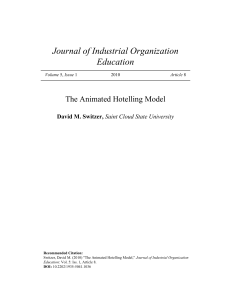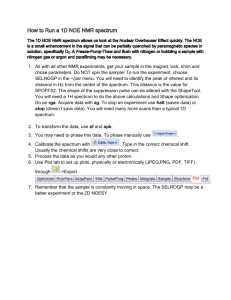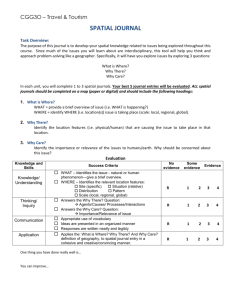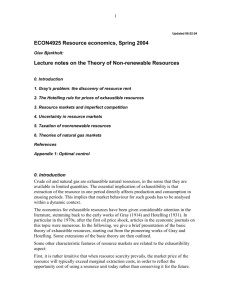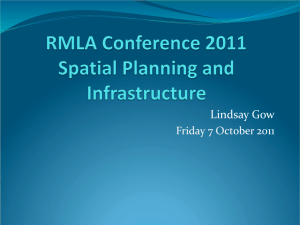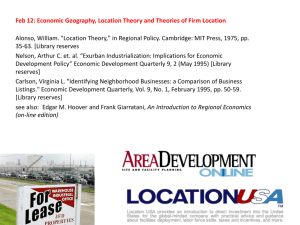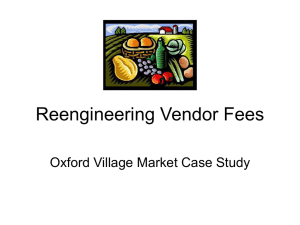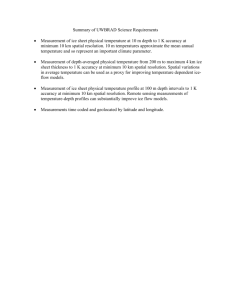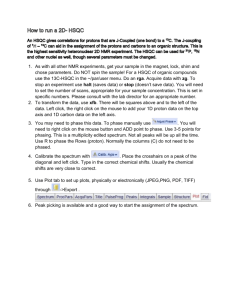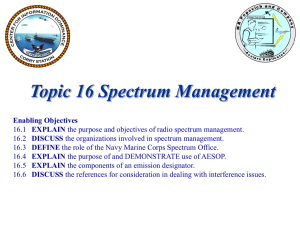Review of Hotelling`s Model in Spatial Theory
advertisement
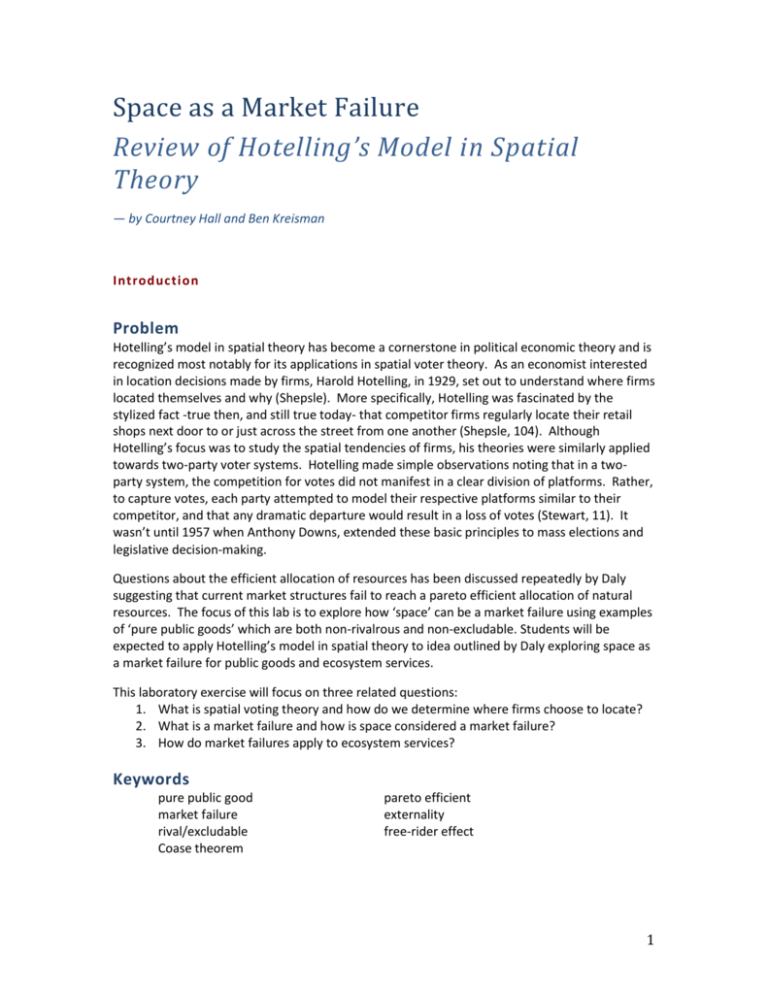
Space as a Market Failure Review of Hotelling’s Model in Spatial Theory ― by Courtney Hall and Ben Kreisman Introduction Problem Hotelling’s model in spatial theory has become a cornerstone in political economic theory and is recognized most notably for its applications in spatial voter theory. As an economist interested in location decisions made by firms, Harold Hotelling, in 1929, set out to understand where firms located themselves and why (Shepsle). More specifically, Hotelling was fascinated by the stylized fact -true then, and still true today- that competitor firms regularly locate their retail shops next door to or just across the street from one another (Shepsle, 104). Although Hotelling’s focus was to study the spatial tendencies of firms, his theories were similarly applied towards two-party voter systems. Hotelling made simple observations noting that in a twoparty system, the competition for votes did not manifest in a clear division of platforms. Rather, to capture votes, each party attempted to model their respective platforms similar to their competitor, and that any dramatic departure would result in a loss of votes (Stewart, 11). It wasn’t until 1957 when Anthony Downs, extended these basic principles to mass elections and legislative decision-making. Questions about the efficient allocation of resources has been discussed repeatedly by Daly suggesting that current market structures fail to reach a pareto efficient allocation of natural resources. The focus of this lab is to explore how ‘space’ can be a market failure using examples of ‘pure public goods’ which are both non-rivalrous and non-excludable. Students will be expected to apply Hotelling’s model in spatial theory to idea outlined by Daly exploring space as a market failure for public goods and ecosystem services. This laboratory exercise will focus on three related questions: 1. What is spatial voting theory and how do we determine where firms choose to locate? 2. What is a market failure and how is space considered a market failure? 3. How do market failures apply to ecosystem services? Keywords pure public good market failure rival/excludable Coase theorem pareto efficient externality free-rider effect 1 Student Activity As mentioned in the introduction, Hotelling’s model of spatial theory was the result of trying to understand why competing firms locate in close proximity to each other. His theory used the following reasoning: Begin with the assumption that the figure below represents a road running through town with the town’s population distributed evenly along the road at evenly spaced intervals. Merchant A, and merchant B want to set up shop selling the same goods at the same prices. As a result, patrons will choose a store located closest to them in order to avoid incurring greater travel costs. Ultimately, the question that Hotelling was interested in is where should A and B locate their stores to maximize profits? A B A B A/B The figure above represents various locations at which merchant A and B can locate their business. The spectrum at the top is marked with the locations of both merchant A and B, the center of town marked with a dashed line and the point directly halfway between A and B. Patrons who live to the left of the halfway point will shop at store A and the patrons who live to the right of the halfway point will shop at store B. In this case, merchant B will obtain a larger number of customers because the halfway point between A and B is located to the left of the center of town. Also, knowing that patrons are distributed evenly, B will have greater profits. For the purposes of this model, assume that each merchant can move their store at no cost. In the second spectrum, notice that merchant A relocated to the center of town, moving the halfway point between A and B to the right of the center of town. As a result, A will capture a larger portion of the population because everyone living to the left of halfway point between A and B will shop at store A. Intuitively, merchant B, will ultimately relocate the store to the center of town noted in the bottom spectrum. At this point, there is no incentive for either vendor to deviate from this final location. 2 EXPLORING THE HOTELLING MODEL IN SPATIAL THEORY The link below has been created to explore spatial theories developed by Hotelling and outlined in the text above. Use the interactive tool to answer the following questions. http://mysite.du.edu/~qliu4/webapp/hotelling/ 1. Begin by clicking on the VENDOR tab so that there are two vendors on the spectrum. Also, set the total number of customers to 20 (this should help visualize the model a bit better and allow for more variability in numbers). Click on the equal/random tab until the distribution of customers along the spectrum is equal. Where are the two vendors located along the spectrum? What is the total distance traveled by customers to reach either vendor? Explain why the vendors are located where they are under these conditions. 2. Under the same settings (20 customers; 2 vendors, equal distribution), click and drag the position of each vendor to half the distance between the end of the spectrum and the center of the spectrum for each vendor. Is it possible to move both vendors away from the center to a point where each of the distances traveled by customers is also equal? What are the distances you noted using the spatial tool? Is this considered optimal or pareto efficient? Explain? 3. Use the same setting as the previous two questions, but this time, click on RANDOM so that the distribution of customers is not uniform. If both vendors are located in the middle of the spectrum (similar to an equal distribution with 2 vendors) what happened to the over all distances of customers for each vendor? Will an optimal location for each vendor be in the middle of the spectrum? PURE PUBLIC GOODS AN D SPACE AS A MARKET FAILURE A public good or ‘pure’ public good is a good that is considered non-rival and non-excludable. This implies that any use of the good cannot prohibit use by others, and that the use of a good does not significantly impact the quality or quantity of the good in question (Daly, 2004). Excludability is almost always associated with the concept of property rights such that if a good is not owned, it cannot be efficiently allocated by market structures. Recall that ecosystem services are the benefits humans receive from ecosystem functions. These services are both non-rival and non-excludable. 4. How does ownership affect market allocation of these services? How does space create a problem for allocation of ecosystem services on the market? Explain the free-rider effect as an example of a market failure and provide a real world example. 5. Economists often suggest that in the case of public goods, assigning property rights will effectively eliminate problems of externalities (Daly, 2004). Explain the term externality and provide an example of both a positive and negative externality. Why is it difficult to establish payments for ecosystem services? Explain using the Coase Theorem. (see chapter 10) 3 Resources Daly, Herman E. and Joshua Farley. Ecological Economics: Principles and Applications. Hotelling, Harold. “Stability in Competition”. The Economic Journal , Vol. 39, No. 153 (Mar., 1929), pp. 41-57 Shepsle, Kenneth A. Analyzing Politics: Rationality, Behavior, and Institutions, New Institutionalism in American Politics. 2nd edition. Charles Stewart III, Analyzing Congress. New York: Norton, 2001 4
